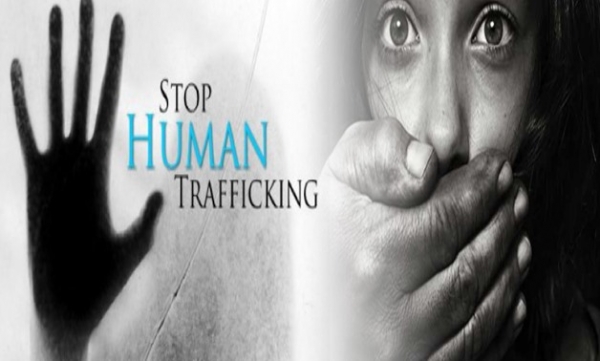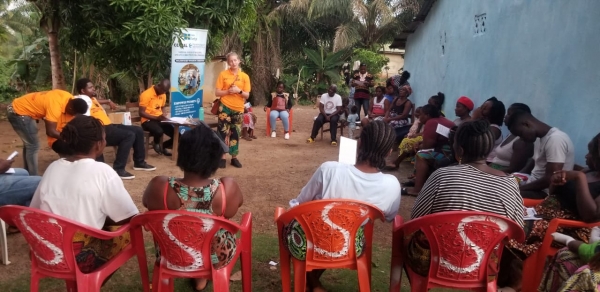
Articles (20)
EXPLORING THE LINK BETWEEN TRAFFICKING AND CORRUPTION
By: Atty. Isaac F. Nyantte, Jr.
CENTAL has an Advocacy and Legal Advice Center (ALAC), where cases bordering on corruption and other unwholesome practices are reported. One of such cases involved an instructor at a school in Monrovia, who attempted to have an affair with a female student as a pre-condition for returning her telephone that was seized by him. He had asked the student to retrieve the phone from his house. But the student did not go alone. She was accompanied by a friend. This had the teacher upset as the presence of the friend worked to abort plans of the affair. He did not give the phone to the student as promised. The student’s mother, being upset by the instructor’s action, proceeded to the campus and forcibly retrieved the phone from the school. Sadly, the student was expelled by the School on the basis of her mother’s conduct.
This matter was brought to CENTAL’s ALAC, which then intervened to ensure that the girl returns to school. Yet, the school remain adamant. It would not even give the girl her documents to enable her enroll in another school. ALAC referred the matter to the Ministry of Education (MoE) and remained engaged with the investigation. The MoE established that the school’s action was arbitrary and not in conformity with law, instructed the school to re-instate the girl. Nonetheless, because of the toxicity associated with the school, the girl opted to enroll in another school. All necessary documents were then given to her. The school is yet to take action against the teacher. This is yet another classic example of how women are subjected to different forms of violence every day.
Gender-based violence is not only an issue widely seen in Liberia, it is common in many societies due to societal structures, crisis, or breakdown of law and order. This was widely seen during the heat of the Liberian crisis, when violence was used as a weapon of war to enslave women.
For many young girls and women, this situation which occurred during the war days, still continues today, with families concealing the information for fear that their girl child would become stigmatized by society. The UNHCR Liberia Factsheet January – December 2019, reported that Rape remains the most reported form of gender-based violence reported in Liberia. According to the report, 46% of cases under investigation by the Liberia National Police during the period concerned children under the age of 18years. Another form of violence, sexual extortion or sextortion, which is a form of corruption, is also occurring in the Liberian society. According to CENTAL’s State of Corruption Report (SCORE) 2021, 12% of Liberians witnessed sextortion during the year preceding the survey. This is a significant number especially considering the veil of secrecy, culture of silence, and backlash of stigma that tend to be associated sextortion. In other words, the extent to which the menace is occurring is possibly greater though it might not be public for many to see.
During the civil war, the perpetrators were mainly rebel forces. However, after the conflict the perpetrators include not just ex-combatants, but community or family members, teachers, husbands or partners. GBV does not only lead to physical and mental trauma for the victim. It often carries longer-term social consequences for the victims themselves, such as stigmatization by their families and the community. Around 15 percent of those who were raped ended up getting pregnant. A high rate of divorce and wife abandonment often follow.
Reports from the Ministry of Gender and Development in 2008 show a similar trend: 34 percent out of over 10,000 reported protection incidents are GBV related. Domestic violence is the most prevalent of all protection incidents (26 percent out of all reported cases).
Taking a cursory look at the relationship between gender and corruption, studies show the relationship between the women in positions of power in countries around the globe, with emphasis on anti- corruption measures in place, to that of the opposite gender. Findings show that with more women in power, there were less forms of corruption. Gender as viewed from different cultures, influence the lives of men and women in different ways.
In many typical African societies, women are limited to domestic work and are regularly confronted with corruption when dealing with education, health and other public services. According to a UNODC Report titled” The time is now” Addressing the gender dimensions of Corruption, and published in 2020, In the health care sector, women are particularly vulnerable as they have reproductive health needs that may require regular attention. They can face corruption for things as simple as getting appointments to having to pay for treatment that they should have received for free. On a daily basis in Liberia, at different health facilities , women have to pay unjustified fees after having to go through so much procedure, only to get medical treatment. A network dominated by men, whether in the public or private sectors, works at the exclusion of women, so that they don’t have access to some cardinal information, or political space.
On the other hand, women in leadership roles have been shown to be more motivated and invested in addressing aspects of corruption that are closer to their own reality, i.e. in areas such as public service delivery of health care and education. They may also be more interested in addressing the gendered currency of corruption, namely where women are asked for sexual favours to access services that are, in fact, sometimes even free.
In conclusion, a preventive strategy targeting men and women that strives for knowledge, attitudinal and behavioral change, by raising awareness of SGBV across all these pillars remains cardinal, especially as we commemorate 16 days of activism. This must involve a mix of advocacy and public awareness campaigns using various media at the community, county and national level.
Liberia: Gender and Corruption
By: Sam Z. Zota, Jr.
Corruption is defined as the abuse of entrusted power for private gain. It erodes trust, and exacerbates inequality, poverty, social division and the environmental crisis.[i] It also affects different genders, leaving marginalized groups mostly impacted. Women, youths, and the poor are often victims.
International organizations have identified four (4) intertwined areas in which women are subjected to corruption: (i) when accessing basic services, markets, and credit; (ii) while engaging in politics; (iii) in situations where women’s rights are violated (e.g., trafficking and sexual extortion); and (iv) negligence and/or mismanagement – where women report poor service delivery due to failure of leaders to hold accountable subordinates engaging in corruption.[ii]
According to the SIDA Gender Tool Box 2015, corruption in public service delivery affects women disproportionately more than men due to the higher vulnerability of women living in poverty and being responsible for the care of children and elderly. Women in some phases of life also have greater needs for health services, especially in their reproductive years. They require access to health care before and during pregnancy and after delivery. In these situations, women may be subjected to corruption, for example in the form of bribery, by health service providers at different stages of their health care needs. The State of Corruption Report (SCORE) 2021 released by the Center for Transparency and Accountability in Liberia (CENTAL) indicates that Sixty-five (65%) of females rated medical services as the service most prone to corruption. According to the report, Corruption in the health sector intensifies inequality, with poor people and other marginalized groups being hit the hardest. The SCORE further indicated that there remains a proliferation of fake and expired drugs on the market (Liberia Revenue Authority, 2020), with long queues at hospitals, inadequacy of hospital beds, shortage of medical supplies, and below par attention from caregivers affect bribe payments as patients seek medical care. At some public facilities, in addition to the cost of services, patients shoulder operational expenses such as electricity costs (CENTAL, 2021). And in the midst of these lapses, those in charge of regulating the sector have been implicated in corruption and self-dealing.
Furthermore, corruption shrinks public revenue, often cutting spending on education, healthcare, family benefits and other social services. This seriously undermines the welfare of women and children who rely mostly on such services provided by the state (SIDA Gender Tool Box, 2015). Recently, Foreign Minister Maxwell Kemayah admitted that a “black market” at the Ministry of Foreign Affairs has been responsible for hike in fees for services and failing to have collections reported to government revenue (The New Dawn, 2021). Not only is such dubious activity shrinking revenue, it is also hindering access to passport services.
The SCORE 2021 also found that Liberia’s national budget has been used as a tool to promote corruption. “State resources are being dispensed through the budget as a reward for political support. The national budget is also being used as a tool to foster what can only be called, however oxymoronically, legalized corruption”, the report stated.
Studies show that there is a broad consensus that corruption hits the poor and vulnerable groups the hardest, especially women, who represent a higher share of the world’s poor. Corruption also hinders progress towards gender equality and presents a barrier for women to gain full access to their civic, social and economic rights. In societies, like Liberia where women are traditionally the primary caretakers for their families, they are often dependent on public services like health or education. This makes them more vulnerable to certain types of bribery at the point of service delivery.[iii]
For women and girls to get access to basic services (education, health, water, sanitation, and electricity), documentation (licenses, residence and identity cards), and law enforcement, they may not only be forced to pay bribe, but are also exposed to sexual extortion. These acts often go unreported due to the stigma and shame associated with sexual crimes. This makes it difficult to monitor the nature and frequency of such corrupt practices. According to the SCORE 2021, 12 percent of Liberians indicated that they witnessed sextortion over the last 12 months. In this type of corruption, sex becomes the currency of the bribe and people are coerced into engaging in sexual acts in exchange for essential services, including health care and education.[iv]
Understanding the complex relationship between gender and corruption is therefore an essential step towards furthering women’s rights and eventually levelling the playing field between women and men.
Today, it is recognized that gender aspects influence and shape cultures across the world and feature in diverse areas of lives, ranging from religious teachings to the common bedtime story. Building upon this universality, corruption affects men and women differently across the world. In many societies as Liberia, women remain the primary caretakers of the family and are regularly confronted with corruption when providing these services. The reproductive needs of women make them particularly vulnerable in the health care sector.
But women are not only victims of corruption; they are also part of the solution. While evidence is inconclusive on whether women are less corrupt than men, greater women’s rights and participation in public life are associated with better governance and lower levels of corruption in many countries of the world. Empowering women and promoting their participation in public life is essential to address the gendered impacts of corruption and level gender power imbalances and inequalities.
Gender inequality interferes with women’s ability to advance at all levels of politics and decision-making, thereby obstructing their access to political participation. Corruption also disrupts efforts to combat different forms of violations against women. Corruption tampers with justice systems and makes it difficult to drastically deal the violence against women. Perpetrators of violence against women continue to walk-away with impunity thereby undermining efforts to stem down on the crime.
Despite all odds, women still remain a part of the solution and have an important role to play in anti-corruption campaigns. They can contribute to improve accountability and integrity systems and build governance frameworks that are more responsive to their needs. Involving women in public life, including but not limited to anti-corruption and the design of gender responsive and gender sensitive anti-corruption policies is an important step in this direction. Indeed, we must all join hands to end all forms of violence against our women and girls now. Yes, we can; working together as ‘One People, One Nation and One Destiny!
[i] What is corruption? - Transparency.org
[ii] https://cdn.sida.se/publications/files/-gender-and-corruption.pdf
[iii] https://www.transparency.org/en/our-priorities/gender-and-corruption.
[iv] https://www.transparency.org/en/our-priorities/gender-and-corruption.
Poor Planning Results in Wasted Public Funds and Unused NTA Terminals in Three Counties
Written by Super UserBy: Sampson David

BUCHANAN Grand Bassa – Liberians in three counties – Bong, Margibi, and Grand Bassa – have expressed grave concern over the abandonment of bus terminals by the National Transit Authority.
Citizens have complained that although the NTA terminals in Buchanan, Grand Bassa and Gbarnga, Bong have been completed, they were abandoned by the transit agency. Meanwhile, construction of a terminal in Kakata, Margibi remains stalled, eight years since the project began.
Previously known as the Monrovia Transit Authority, the NTA was transformed into a nationwide transportation system by an act of the legislature in 2009.
In April 2013, the agency began constructing Buchanan’s terminal through a private construction firm, Dougbor Group Incorporated, for US$97,219. The construction was completed and the terminal turned over to the NTA, but it remains unused.
Although NTA buses frequent the Buchanan to Monrovia route, passengers alight and board the buses at different locations along the streets of Buchanan instead of using the terminal. This happens even during heavy rainstorms, from which the terminal was designed to shelter passengers.
One reason the Buchanan terminal has never been used is the lack of proper planning and public consultation in selecting the location. Barley Tokpah, head of the local chapter of the National Civil Society Council of Liberia, said the terminal’s location is unsafe and not easily accessible.
Tokpah elaborated that the terminal’s location within the On Your Own Community, as opposed to a central and well-lit neighborhood, makes it an unsafe destination for passengers wishing to take trips during the early morning and late evening hours. The road to the terminal is far, dark, and isolated – all conditions that encourage criminal activities and attacks on them, Tokpah said.
He added that the decision of the terminal’s location was likely based more on where the government already had available land, instead of where was most suitable for a terminal that connected passengers from across Buchanan.
“From government to government, we’ve lack consultations at the local level,” he said. “Now that the road is not paved, [there’s] no electricity, and the building has been abandoned, I can say that it was not appropriate to build it there, taking into consideration the prevailing circumstances.”
He called on the NTA management to take responsibility of the situation because they did not conduct the required assessments before constructing the terminal.
Emmanuel Wragboe, a Buchanan resident, recommends that the heads of the agency who initiated the terminal project be made to pay for the taxpayer funds they wasted.
“This is [a] waste of taxpayers’ money,” he said. “If you are carrying development somewhere, you need to send your assessment team to do an investigation as to whether the place you want to do the development will be conducive for the people.”
Like the Buchanan terminal, the Gbarnga NTA terminal that was constructed under former managing director Karmo Ville’s administration is not being used. Bong County Youth Coordinator Dakai Mulbah described the abandoned terminal as a waste of public funds and blamed poor planning.
“The government used a lot of public resources to build this terminal, and it has been abandoned by the NTA itself and the citizens – it is a complete waste of public funds,” Mulbah said.
“The government cannot be spending a lot of money on something that is not conducive for the people. Now you see the people sitting under the rain, sun, and on the road awaiting car – it is wrong.”
The Gbarnga terminal is located on the Lofa highway, a significant distance from the center of the Bong capital.
“If the citizens were involved, they couldn’t have allowed the terminal to be built in that area,” Mulbah noted. “If you want to carry out development for a group of people, involve them. Anything that is not done properly is not done at all.”
Mulbah laments that so much government resources were wasted on buildings that would never be used: “That money should have been used on something different that would have improved the lives of the people.”
Meanwhile, in Margibi, residents still wait in the rain and scorching sun to board NTA buses. The construction of an NTA terminal has remained stalled for years.
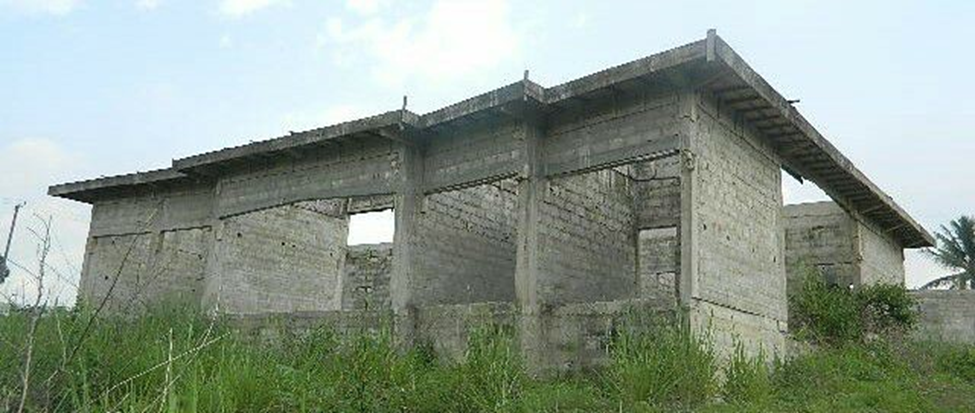
Kakata NTA Terminal under construction. Photo by Yawah Jaivey
In 2013, construction of the Kakata terminal began but was interrupted during the 2014 Ebola outbreak. Seven years later, the project has remained on hold even though Ebola was eradicated from Liberia in 2015. The Dougbor Construction Company, which constructed the Buchanan terminal, also won the bid for the terminal in Kakata that was funded by the National Oil Company of Liberia, NOCAL.
In 2017, NTA’s then public affairs officer, Robert Wilson, told The Bush Chicken that the oil company agreed to fund the construction of terminals in Kakata and Bo, Grand Cape Mount.
The head of Margibi’s chapter of the National Civil society Council of Liberia, Friday Cursor, says he is concerned about the unexplained delay in the construction of the terminal.
NTA’s managing director, Herbie Teconbla McCauley, has turned down a request for a face-to-face interview to respond to concerns of abandonment of the terminals in the counties. Via text message, he blamed COVID-19 for the construction delay.
“Due to COVID, our partners that [are] supposed to carry [on] the project [have] been unable to because of the travel restrictions in China. However, as soon as things improve around the world we can assure our customers those projects will be undertaken,” he wrote.
McCauley refused to address the abandonment of already completed terminals. However, in 2018, the agency’s then corporate communications officer, Jimmy Tybalt, who is now operations manager, admitted in an interview that NTA had abandoned the terminal in Buchanan. Still, he blamed Ville, the former managing director, for authorizing the project. He told The Bush Chicken that the current administration would decide on the way forward.
This story was earlier published on the Bush Chicken and is a collaboration with the Center for Transparency and Accountability in Liberia (CENTAL) as part of the Ant-Corruption and Investigative Journalism Fellowship with founding from Sweden Sverige. The sponsor has no input in the story and the story does not necessarily reflect her views.
Featured photo by Sampson David
Corruption in Rivercess: What’s Behind 'The Bridge that Never Is'?
Written by Super UserBy: Gabriel B. Sawah
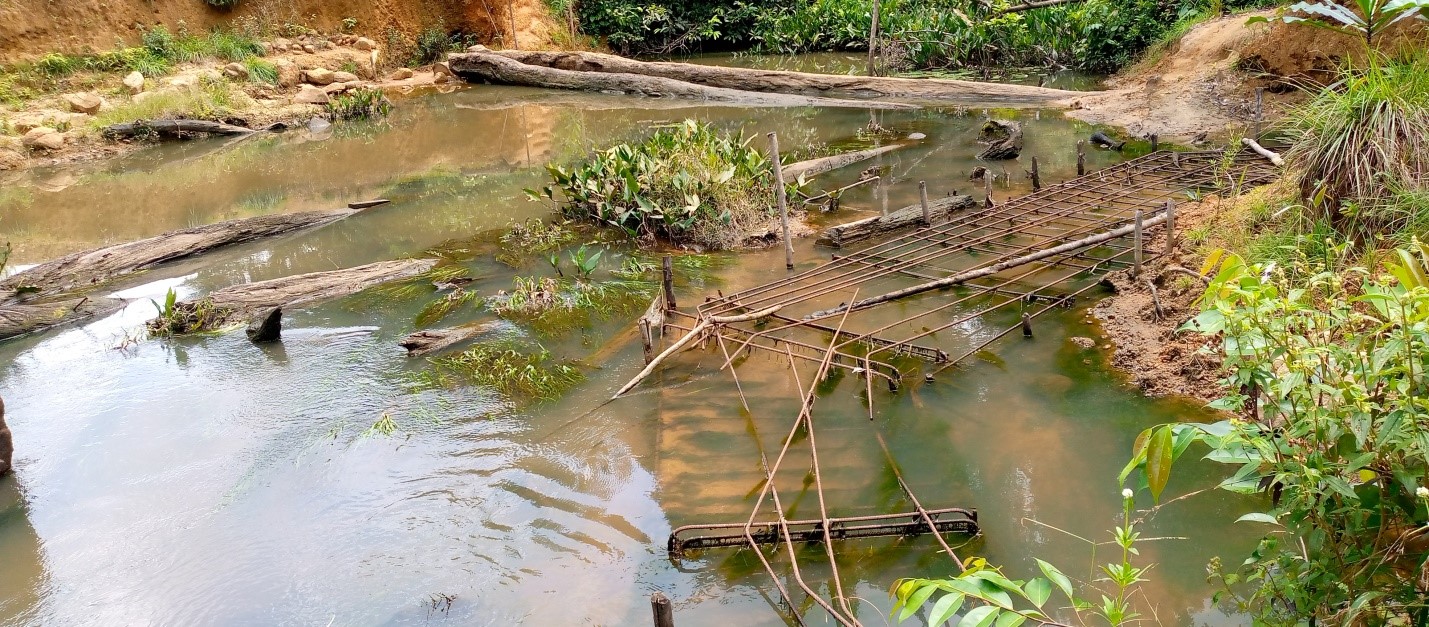
Current status of the Draw River Bridge Project in Zahnflahn Administrative District
This is the Draw River. Located near Zorh Town, River Cess, the river is calm and shallow in the dry. But when the rains come, it deepens and overflows. The community has been bedeviled by this seasonal challenge for many years and has intensely hoped for a lasting solution. The community would take a giant step towards the construction of a bridge but once public officials got involved, politics and corruption surfaced. The Bridge is yet to be.
Meet Comfort Gardehway, a 27-year-old mother of two residing in Wholozohn Clan, Zarflahn Administrative District, River Cess County. Like many of her peers, she worries about her children’s education as the raining season intensifies. According to her, most kids (hers included) are unable to attend school when the Draw River overflows.
She says that when the river overflows during the rains, women in labor often have to wait for days to make the crossing or, alternatively, are carried in hammocks to nearby health facilities. “Some even give birth at the riverside and are attended to by traditional midwives”, she added.
Due to these and many other challenges, the community decided to construct a bridge. Thanks to land rental fees paid by the EJ&J Logging Company for carrying out commercial logging operations in the community forest.
In 2019, the community, through its Community Forestry Development Committee (CFDC), entered an agreement with LIDA (Liberia) Limited for the construction of a bridge valued at One hundred and Six Thousand United States Dollars (US$106,000). Of this amount, Thirty-Five Thousand United States Dollars (US$35,000) was to be provided by the CFDC and the remaining amount was to be sourced from the County Social Development Funds (CSDF) through a County Sitting resolution. The agreement was signed by the CFDC Chairperson Mathew Walley, then Legislative Caucus Chairperson Senator Dallas A.V. Gueh, Project Management Committee Chairperson Romeo Alphonso Kebbeh, Fiscal Affairs Superintendent Cyrus Elijah Kaysaynee and the Chief Executive Officer of LIDA (Liberia) Limited Marshall David Yeanue.
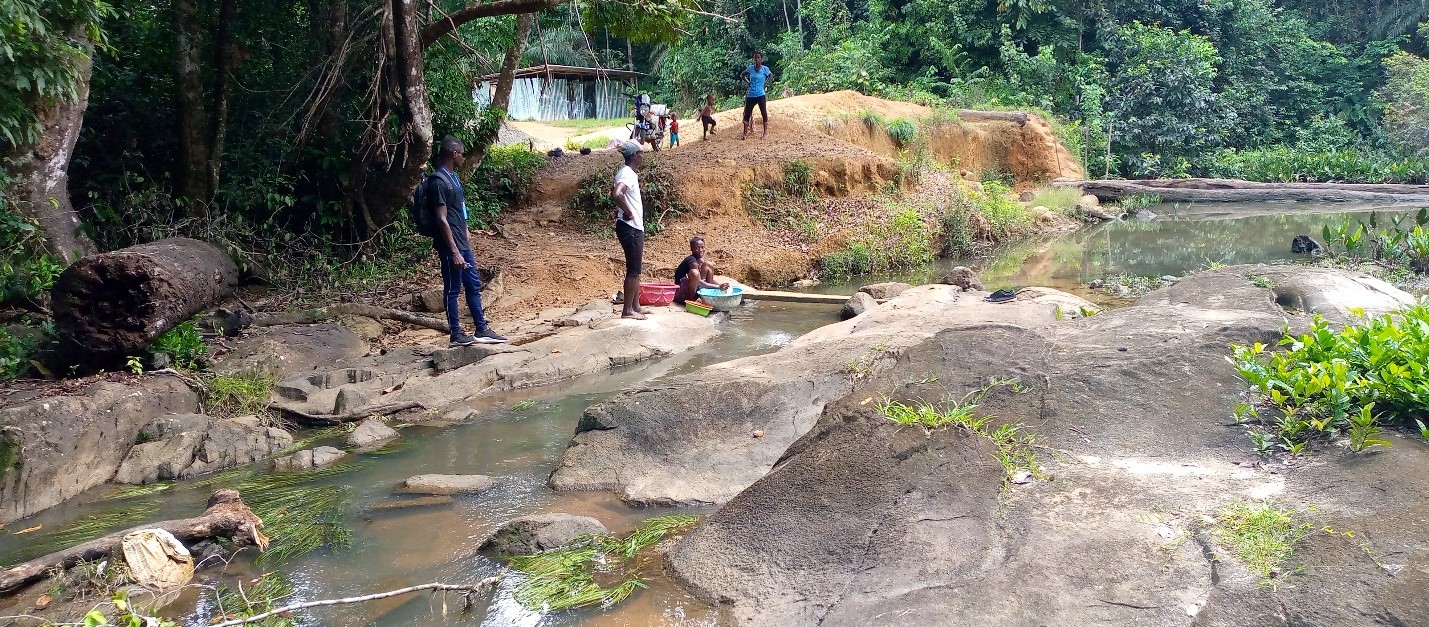
View of the construction site
But two years later, the bridge project has barely begun. This has created a Pandora box as many wonder who is really telling the truth. Accusing fingers have been pointed from one end to another. County officials have said that the contractor (LIDA) brought in substandard materials, something which prompted them to issue a stay order on the construction. On the other hand, the head of the CFDC, Mathew Walley, has attributed the stalemate to the fact that county officials received money from the contractor, coupled with officials’ refusal to disburse the CSDF share of the project cost.
“The Development Superintendent Amos Somah halted the construction work because he said the contractors were using low quality materials, but when we went there for verification, the Development Superintendent only identified the steel rod on grounds that the steel should have been 16mm instead of the 14mm that was used”, Walley of the CDFC said. But Walley himself has been accused of selling materials procured for the project. When confronted, Walley claimed that 100 bags of cement were given out to a business as a safeguard and would be replaced. When quizzed, this is how he responded: “so if we took it out for safety, is that not sufficient? I told you that the business that used it is waiting to replace it. What next will you ask? What I want you to do as an investigative journalist is to find out what is holding the bridge now? Why has the project delayed? What is the responsibility of the parties?”, he responded to our inquiry.
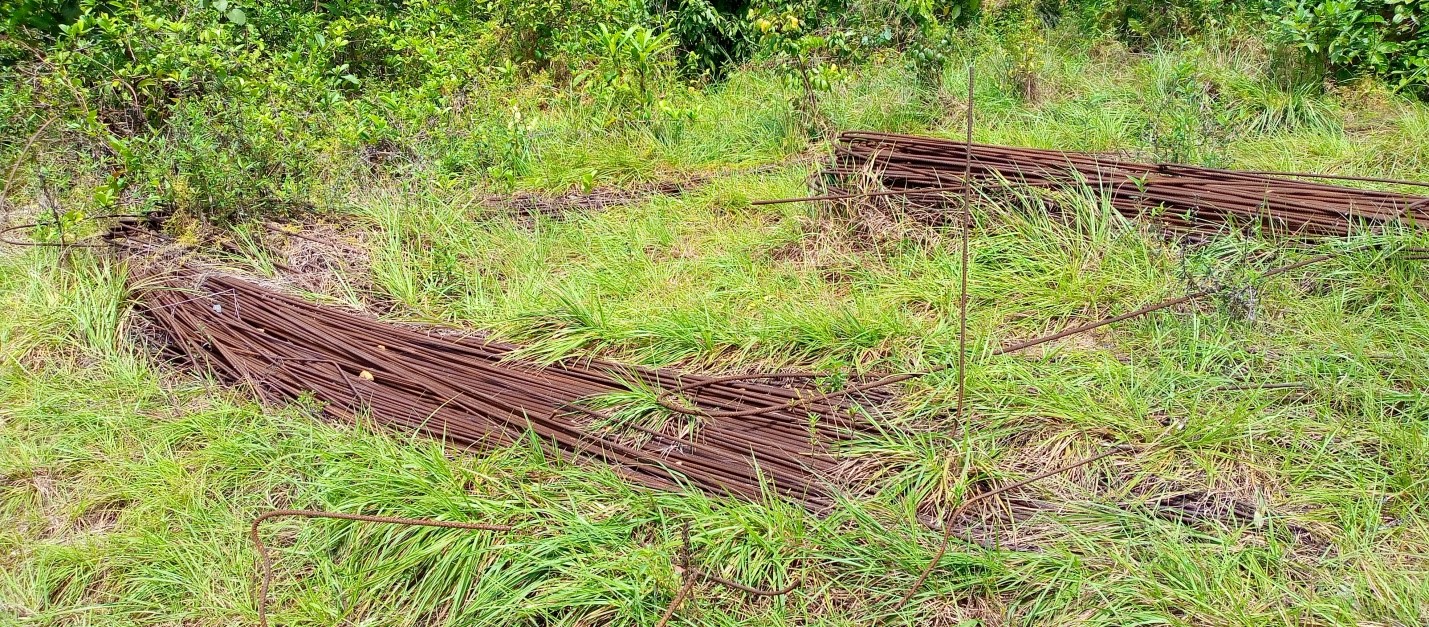
Steel rods brought in by the company lie exposed at the project site
On March 19, 2021 a group under the banner Concerned Citizens Movement of Wholozohn Clan filed a complaint against Mathew Walley, head of the CFDC, to the 14th Judicial Circuit Court for River Cess County demanding answers about why the project has not resumed although materials are available at the project site.
Based on the group’s complaint, the court on April 5, 2021 cited the contractor (LIDA) through its Chief Executive Officer, Mr. Marshall David Yeanue, Mathew Walley of the CFDC and Development Superintendent Amos Somah to appear and show cause why construction works have not resumed. At the hearing, the contractor admitted receiving Thirty-Seven Thousand United States Dollars (37,000.00USD) from the CFDC instead of the initially agreed Thirty-five Thousand United States Dollars (35,000.00USD). The contractor assured the court of resuming work. Strangely, the contractor has recently argued that the contractual agreement placed the project duration at six business months and that since the duration has expired, work would not resume until County authorities compensate for damages encountered as the result of the stay order, which it says lacks technical basis.
A highly placed source who spoke to us on condition of anonymity said the stay order issued by Development Superintendent Amos Somah was motivated by personal interests. According to the source, Somah stopped the construction work because the Bid Evaluation Committee denied a construction firm, which he is linked to, the bridge construction contract. According to the source, Somah was also a member of the Bid Evaluation Committee and had attempted to turn the tide in favor of the company. However, other committee members resisted.
The source also hinted another reason for the inability of County officials to take actions against the seemingly daring contractor. According to the source, the contractor (LIDA) gave Six Thousand United States Dollars (6,000USD) to Development Superintendent Somah and Assistant Fiscal Affairs Superintendent Cyrus Elijah Kaysaynee as “credit” to facilitate holding of the 2019 county sitting. Our investigation also revealed that the money was delivered to the officials by the contractor after the community had made good its share of the cost for the Draw River Bridge Project. The amount was withdrawn from the Forestry Management Committee Area B(FMC-B) account by CFDC Chairperson Matthew Walley and was presented to Fiscal Affairs Superintendent Elijah Kaysaynee and Development Superintendent Amos Somah. A source closed to the transaction said the contractor had earlier told the County Officials that the money he was crediting the county was part of the project fund.
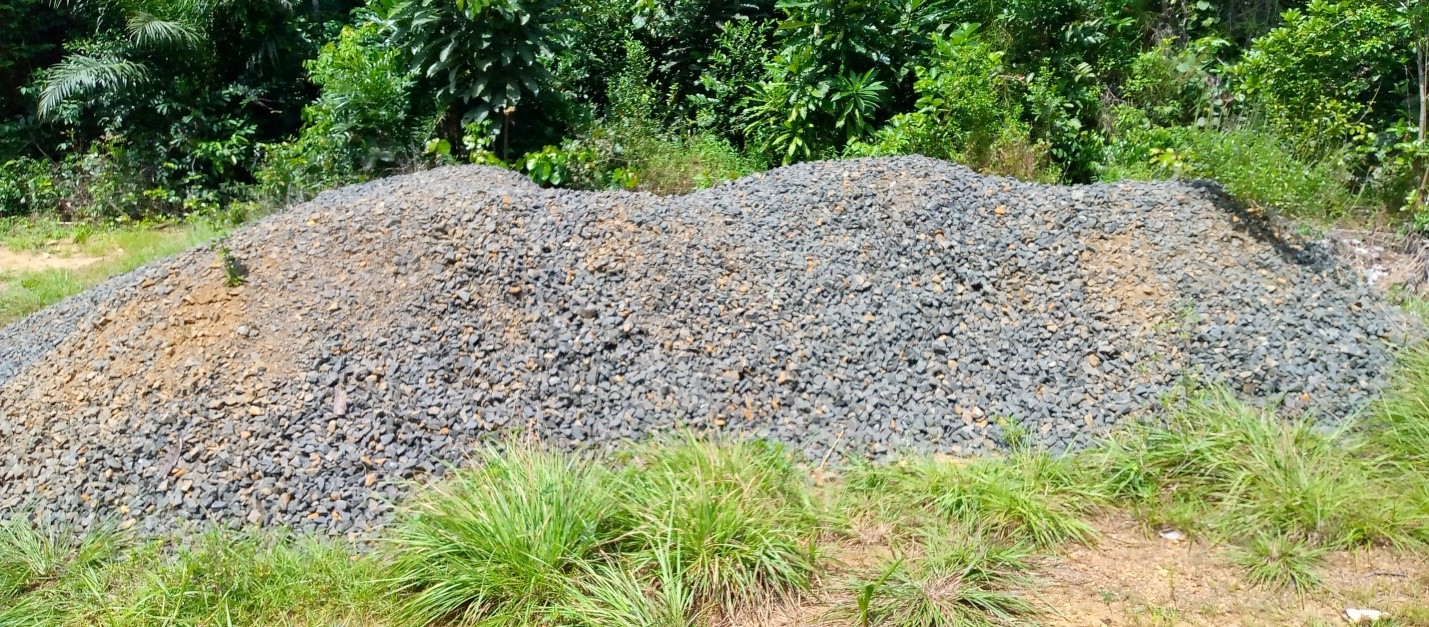
Crushed rocks deposited at the project site
When contacted, Fiscal Affairs Superintendent Elijah Kaysaynee denied receiving any money from the contractor for personal affairs but argued that the county credited money from FMC Area K not Area B.
“We took money from the FMC Area-K; we did not take money directly from Marshall Yeanue, but we took money from the CFDC with an agreement, not with Marshall” he reacted.
Meanwhile, River Cess Project Management Committee (PMC) Chairperson Remeo Alphonso Kebbeh has said that the disbursement of the Thirty-Five Thousand United States Dollars (USD$35,000) was done by the Fiscal Affairs Superintendent Elijah Kaysaynee and the CFDC chairman Mathew Walley without the PMC involvement.
“The Fiscal Affairs [Superintendent] called me before they give the money to the contractor and he came back to River Cess and told me they had the entire transaction document” he explained.
Development Superintendent Amos Somah says the county will not give LIDA a dime to continue the project; adding that neither the county nor the community is obligated to LIDA (Liberia) Limited. He said he halted the project because of the substandard materials and that Mathew Walley and Marshall Yeanue must be held accountable for the failure of the project. Sadly, these materials remain exposed at the project site and stand the risk of theft.
There are many questions that remain unanswered as the Draw River remains a nagging concern for locals. Patriotic sons and daughters of the county are wondering why the contractor (LIDA) alone will challenge the entire county and the leadership remains mute and inert. Aren’t county officials complicit and compromised by their “credit” of funds intended for the project? Is it not the responsibility of government to fund county sittings? Why is the CFDC which manages community forest revenues not taking any action? And why did the CFDC sell over 100 bags of cement intended for the project without the citizens concern? Plus where are the funds from the sale? Are communities being robbed by county officials of the little they have to benefit from extraction of their forest resources? These questions may remain unanswered now but, with growing citizens’ demand for accountability, the answers might just come sooner than expected. Meanwhile, we continue to hope that the Draw River Bridge project delivers an actual bridge rather than a bridge only on paper.
About the Author
Gabriel B. Sawah is a CENTAL Investigative Journalism Fellow and Manager at the Development Communication Network (DCN) Radio in Cestos, River Cess.
Editor: This article was edited by Gerald D. Yeakula, Esq., Program Manager at the Center for Transparency and Accountability in Liberia (CENTAL).
Editor’s Note: This article is made possible through the National Integrity Building and Anti-Corruption (NIBA) program implemented by CENTAL with funding from the Swedish International Development Cooperation Agency (SIDA) through the Embassy of Sweden. The donor has no input in the story and it does not necessarily reflect her views.
By: Gloria Wleh
The James N. Davis Jr. Memorial Hospital (JDJ) was once operated by a medical humanitarian organization, Medicine Sans Frontieres (MSF), catering to the medical emergency needs of women and children. Their intervention helped improve access to healthcare for many Liberians. But like all good stories, the MSF-JDJ story came to an end on April 2, 2010 with the turning over of the facility to the Government of Liberia. The hospital has been run by Government ever since but things have not remained the same. In fact, they have gotten worse.
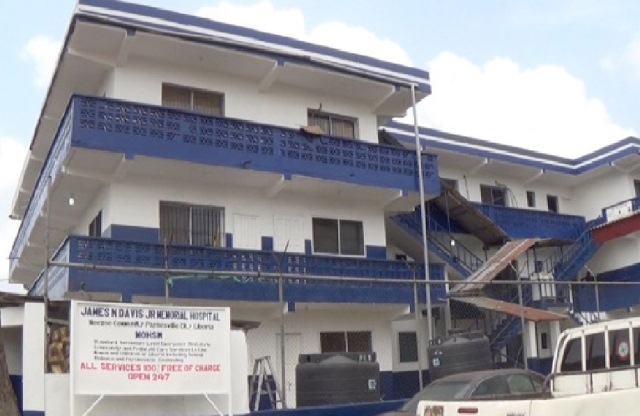
The James N. Davis, Jr. Memorial Hospital in Neezoe. PhotoCredit: GNN Liberia
Ma Korpo Lake is elderly and lives in Totota, Bong County. She sells in the market to get her daily bread. In July, she made a trip to Monrovia to cater to Sonnie Morris—her 25-year old daughter on the verge of bringing forth a child. When Sonnie was grabbed by the pangs of labor, Ma Korpo took her to the St. Benedict Mini Health Center in the Pipeline community, Paynesville. But after three days in labor, the facility referred her to the James N. Davis Jr., Memorial Hospital (JDJ) in Neezoe Community, for surgical operation. She was informed that her daughter was unable to bring forth the baby because the baby was breech.
An anxious Ma Korpo departed for the JDJ in anticipation of a miracle that would save the lives of her daughter and the unborn child. But once at JDJ, things became gloomier. In addition to the cost of the surgery, the public hospital requested Ma Korpo to purchase fuel for the running of the generator before her daughter is extended medical care. “Because they [St. Benedict Mini] were unable to do the work on my daughter, she was transferred to this hospital (JDJ). But as we arrived with her here, they [JDJ] told us to pay three thousand two hundred and forty Liberian dollars for six gallons of fuel, along with ten thousand and eighty-five Liberian dollars for the operation set, before they (JDJ) could touch my daughter." “And I am a market woman from Totota, Bong county; my daughter’s fiancé is a security man who is not employed but serves as a contract-security-guard for stores in Monrovia here; we don’t have the money to pay for all of the medical bill, but they (JDJ) told us that if we cannot buy the items they want, they were not going to cater to my daughter who needed urgent medical attention,” the down-hearted Ma Korpo lamented.
Ma Korpo, who looked scared and worried, furthered that while she was terrified and perplexed about her daughter’s life and that of the unborn hanging in the balance, the hospital kept demanding them to pay for those items before her daughter could be treated.
“We later bought the fuel, but because we didn’t have enough money, we begged the hospital and paid LD$4,700 of the operation set payment, before they attended to my daughter,” she furthered.
“Sonnie’s wound has to be dressed two times daily. We need to buy drugs that cost LD$4,840; including the needles and gloves that are to be used to dress her wound for the next days she is to be receiving treatments; we have gone dry of money to even buy her the first cup of tea that she is supposed to drink every morning and evening; I don’t have anywhere to turn to for help right now”, Ma Korpoe said in a sad tone.
But Ma Korpo is not alone. Like her, Joseph Doe (not his real name) took his pregnant wife to the JDJ for surgical operation, and was also told by the hospital to buy fuel for the hospital’s generator before she could receive any medical attention.
Joseph, who preferred being anonymous, said he had earlier on taken his wife to the Benson Hospital in Paynesville, but was later told by the hospital (Benson ) that his wife needed operation in order to bring forth their child, and that they (Benson Hospital) were unable to carry on such an operation.
“My wife couldn’t give birth all by herself that night, and so she was transferred from Benson Hospital to James N Davis Jr. Hospital for surgical operation, but upon reaching at the hospital, I was firstly told by the hospital to buy six gallons of fuel for their generator, before my wife’s emergency condition could be catered to.”
“I was shocked but with the great fear that was in me of not wanting to lose my wife, I hurriedly paid for the fuel and additional ten thousand plus Liberian dollars for the surgical materials set, which were also required to be paid for in order for her to be treated.”
“I am till this date confused as to whether James Davis Hospital is a government owned facility, or a private institution. Because even at the private facility where my wife was, there were some services and medical material that were freely given to her,” he added.
“I paid for every single thing at that hospital, including the needle and gloves that were used on my wife. That place being an emergency treatment center for women and children seems to be a death trap for low income earners who might go there with the thought of it being a government facility that should have affordable services,” he stressed.
The current situation at the James N. Davis Jr., Memorial Hospital in Neezoe, doesn’t seem to be a new issue there, as a Liberian journalist also explained his scenario when his wife was taken there, four years back.
According to Necus Andrews who reports for The News Newspaper, his wife was taken to the JDJ Hospital for Caesarean section (C-section), and he was told by the hospital, to buy six gallons of fuel for the hospital’s generator, before she could be attended to.
“When my wife was taken to the James N. Davis hospital in Neezoe, they told me to buy six gallons of fuel for the hospital’s generator before my wife could be catered to. Adding that the hospital was financially challenged, and that it was a tradition for patients who go there to be treated,” Journalist Andrews said.
“I was scared of losing my wife, my child, or both of them; so as confused as any other person could be during such a time, I paid for the fuel and other items as asked for, but for someone who might not have to pay, it might turn out to be a death trap for them,” he noted.
“The purchasing of fuel before treatment at that hospital is a serious trauma-game that is played out on patients who go there for emergency treatments, and it poses a very serious psychological threat to a patient’s life. And even though that place claims to provide a health service, I can safely say that that place is a death trap,” he maintained.
”National government needs to pay a very serious attention to the James N. Davis Hospital, by providing the basic materials for the smooth operations of the hospital. Their failure to do so would cause people who do not have the finances to go to this emergency facility for instant service, to lose their lives, or stop them from going there for treatment,” journalist Andrews stated.
When contacted, the head of the James N. Davis Jr., Memorial Hospital in Neezoe, said, “his institution is receiving funding from the government of Liberia, but it is not enough to cover all of the medical needs of the health center which caters to over fifty patients daily."
According to Director General Anthony Quayee, “requesting each patient who goes to the hospital for surgical treatment to buy fuel for the hospital’s generator is the only means by which the hospital is able to cater to the needs of its patients, without its generator having breakdown."
The JDJ boss who also refused to be recorded added that the government has been unable to make available funding to the hospital in full and on time for its operations. Though the JDJ boss was tightlipped on funding received, and when it began receiving funding from the government of Liberia, our investigation shows that the JDJ and the Bensonville Hospital jointly received US$55,457.00 in fiscal year 2019/20. The funds received by these two hospitals amounts to only 55% of funding government provided to Senator Jeremiah Koung’s private hospital (the Esther & Jereline Medical Center in Ganta, Nimba) that year. Meanwhile, the Government has budgeted a meager US$100,000.00 for the two hospitals in the 2020/21 budget year.
When contacted on Thursday, July 22, 2021, the Minister of Health promised to do some assessments at the James N. Davis Hospital before speaking to the situation. But upon being called back on the 27th of July 2021, as requested, there was no feedback provided by her , as she was yet to carry out the assessment as promised. Other efforts to get the Minister’s comment proved futile.
While we await words from the Minister of Health, we can only say that the nightmarish experiences of Ma Korpo and the likes are only a gist of what thousands, if not millions, of Liberians go through while seeking medical care. As many citizens visiting public health facilities complain of squeezing water out of rocks to shoulder said costs, we cannot stop but wonder how the nation treats its own. And for those who unfortunately do not meet up with said expenses, we only grind our teeth hoping that not so many have lost their lives in such situations. Until the Health Minister gets back, we continue to ask: Are public hospitals really death traps?
About the Author
Gloria Wleh is a CENTAL Investigative Journalism Fellow and reporter for The Stage Media (TSM).
Editor: This article was edited by Gerald D. Yeakula, Esq., Program Manager at the Center for Transparency and Accountability in Liberia (CENTAL).
Editor’s Note: This article is made possible through the National Integrity Building and Anti-Corruption (NIBA) program implemented by CENTAL with funding from the Swedish International Development Cooperation Agency (SIDA) through the Embassy of Sweden.
LOCATION
22nd Street, Sinkor
Tubman Boulevard
Monrovia, Liberia
Phone: +231 88 681 8855
Email: info@cental.org.lr
Website: www.cental.org.lr
SUBSCRIBE
Get updates and important events straight to your inbox. We don't spam

